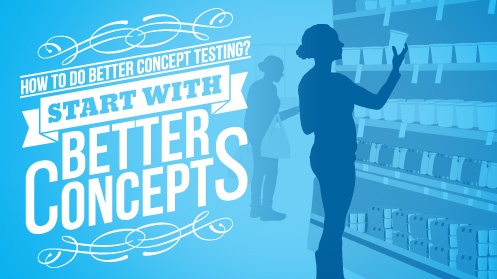
For most companies, some point in the new product development process requires writing a concept statement. And often, the concept statement is quickly dashed off by the marketer or their agency, without a lot of thought. But writing a strong concept statement is as much science as art, and putting in the time to develop the best possible concept statement can pay off in improved new product success rates.
Concept statements usually follow a three-part format: Problem, Solution, Reasons To Believe (RTBs.) And of course always stated from the point of view of your target consumer. Fairly simple, the concept statement for a new product might be:
- “We need to get the orange juice into the trucks faster.”
- You need a bigger pipe.
- This pipe is guaranteed for five years, has a 95% safety record, and is made in America.
However, simply repositioning the concept statement format can lead to improved concept statements. Instead of Problem, Solution and RTB’s, think about the concept statement format as Insight, Benefit, and Trust Builders.
The Insight
Define the problem as an insight, and you’re halfway home. Insights are a clearly stated, compelling belief, some truth about your consumer’s life, or a state of being that is true for your consumer. Problems are not insights, necessarily, and an insight may not be a problem. In order to have an insight, you need to know your target audience. Ask yourself these questions:
- Who is the target consumer? Describe them in demographics: age, gender, income, ethnicity, education, employment. What is their industry?
- How do they use this product? What substitutes and complementary products do they use?
- What are their habits concerning this product?
- How do they shop and purchase this product? Are they the influencer or the final decision maker?
- What attitudes do they have about this product?
The better you know your target audience, the more compelling the insight you will have and will result in a better concept statement.
The Benefit
As Theodore Levitt said, “People don’t want to buy a quarter-inch drill, they want a quarter-inch hole.” In other words, people don’t buy products to have the product; they buy products to gain a benefit. So make sure that your concept statement describes the benefit you’re delivering – not the product you’re selling. Each concept statement should focus on one benefit. And make sure that it is clear how your product delivers this benefit better than any other competitors’ product or the consumer’s current solutions.
Trust Builders
These are product attributes that support the delivery of the benefit. The Trust Builders help the consumer feel confident that they will get the benefit you have promised. Limit your concept statement to only the three to five facts, features, or characteristics that will be the most compelling to your consumer.
Here are some examples of Trust Builders:
- Features of the product, including technology
- Facts about the product: how it is made, what it is made of, packaging, its history or backstory
- The product’s brand, owner, or manufacturer
- Endorsements (from famous people or “experts”)
- Appearance, sound, flavor, texture
Putting it all Together
Approaching the concept statement as Insight, Benefit and Trust Builders might lead you to write a concept statement like this:
“In order to distribute our orange juice to the bottler while it is as fresh as possible, we need to get it on the road faster.”
You need US Pipe to optimize your fruit-to-bottle processes. With higher capacity pipes and pumps, your orange juice is safely and efficiently delivered into the bottler’s trucks. And all US pipe and machinery is made in the USA, for faster maintenance and service.”
In the end, strong product concept statements have the right elements, and also tell a great story. It’s not a process you can short-change, so work carefully through each section of the statement. Start with an outline of the key points, and then write the full sentences, romancing them into an interesting and story and compelling promise. Your new products might not all succeed, but you’ll increase your chances of success by being a disciplined and thoughtful concept developer.
Click here to learn more about research for new product development!
